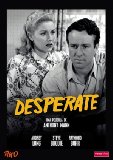
| Cast: | Steve Brodie, Raymond Burr, Audrey Long, Douglas Fowley, Jason Robards Sr. |
| Genre: | Film Noir/Drama |
| Director: | Anthony Mann |
| Screenplay: | Harry Essex from a story by Anthony Mann & Dorothy Atlas |
| Cinematography: | George E. Diskant |
| Composer: | Paul Sawtell |
On his 4-month anniversary, a straight-laced recently discharged G.I. turned truck driver gets an offer he can’t refuse for a night job. Unfortunately, it’s too late when Steve Randall (Steve Brodie) finds out he’s the get away driver for a heist, and getting a cops attention by repeatedly flashing his lights leads to a shootout that sends the policeman to the morgue and the beloved younger brother of head gangster Walt Radak (Raymond Burr) to the electric chair. Radak decides the solution is having Steve take the fall, confessing he roped the poor naive kid into it. A crucial reason Mann’s later works are so great is they deal in ambiguity, showing all humans to have several good, bad, and indifferent characteristics, but with Radak threatening dirty deeds against Steve’s wife Anne (Audrey Long), Desperate is as black and white as they come.
Though belonging to the wrong man and ordinary folks ensnared in an ever tightening vice genres robs the film of the existential angst and gray areas of the best film noirs, and frankly the simply morality is shocking for something coming from the master of the psychodrama, Mann is able to sharply contrast the male and female world almost without our even realizing it. Anne is the ideal wife of her era, never questioning her husband and serving him to the best of her abilities, but our sympathies are with Anne because we can see that she’s right. By keeping her in the dark and not listening to her pleas to go to the police now, Steve makes countless errors, getting them in more trouble and placing them in more danger. However, rather than making Steve the typical hard boiled tough guy loner we’d admire, he takes on the warmth, caring and good cheer of the women he’s surrounded by. These scenes of the loving young couple aren’t tough to take because salt subs for the usual heapings of sugar, literally, in light comic scenes where the baking ineptitude and paranoid delusionalism of the newlyweds are used to exemplify their humanity. In contrast, the male-only scenes are constant head butting, operating through panic inducing intimidation and extortion rather than mutual benefit and teamwork.
The moments of whimsy help establish the regular folks theme that’s crucial to the innocent couple in peril theme, but more importantly the leisurely build (despite the 73 minute runtime) allows inescapable menace to slowly seep into every black frame of the dark film. The plight of the innocent man is such that when he actually pays $90 for a used car that probably wouldn’t even run for someone who didn’t happen to be expert mechanic, the shady salesman refuses to turn it over to him, upping the price to $300. However, far more disturbing than Steve’s string of bad luck is the ambivalence of the cops, which matches that of the criminals. When Steve finally tells his story to the police, the chief inspector, Det. Lt. Louie Ferrari (Jason Robards, Sr.), takes his word even though he doesn’t believe him, allowing him to roam wherever he pleases so as the bait for the rest of the crew.
As you might guess, there are numerous unbelievable and implausible plot points, far more than the usual cat and mouse game. Having a big traditional Czech wedding to please Aunt Klara (Ilka Gruning) when you are supposed to be in hiding doesn’t quite take the cake, as for me the most annoying and illogical part is that Walt recovers from a near fatal shot in the gut by the next scene, continuing for the rest of the movie in perfect health as if he’d instead just returned from a tune-up!
Though Mann had yet to pair with ace cinematographer John Alton, his interest in pitch black is apparent in many scenes, including the classic beatdown of Steve by Radak’s henchmen. Violence is more important to Mann as one of the psychological forms of brutality than for its physical aspects, so even when the later takes over, he can bring forth the former in a visceral manner. Walt’s right hook to a helpless Steve seems to punch the audience more than the victim, as the impression on the viewer is made by the follow through where the blurry fist finishes in our face by almost seeming to punch the camera. We hear Steve’s pain, but we only see enough of it to get the idea, as Mann prefers to focusing on the icy stare of the rigid unforgiving villain and his equally casual and matter of fact goons, rhythmically illuminated by the harsh glare of a teetering ceiling lamp that was struck by a falling Steve at the outset of the fracas and now seems to stand in for the swinging fists.
Alton’s masterful lenswork would bring a more consistently interesting and inventive brand of cinematography to Mann’s work, but his predecessor George E. Diskant, who went on to film such memorable works a Nicholas Ray’s They Live By Night & On Dangerous Ground, Richard Fleischer’s The Narrow Margin, & Ida Lupino’s The Bigamist is excellent at set pieces. The cautious illumination of the tight angular staircase that seems to connect the safety and decency of a loving home with the danger and shadiness of an outside world that strives to bring them down makes a perfect host for the final confrontation between good and evil.
   |